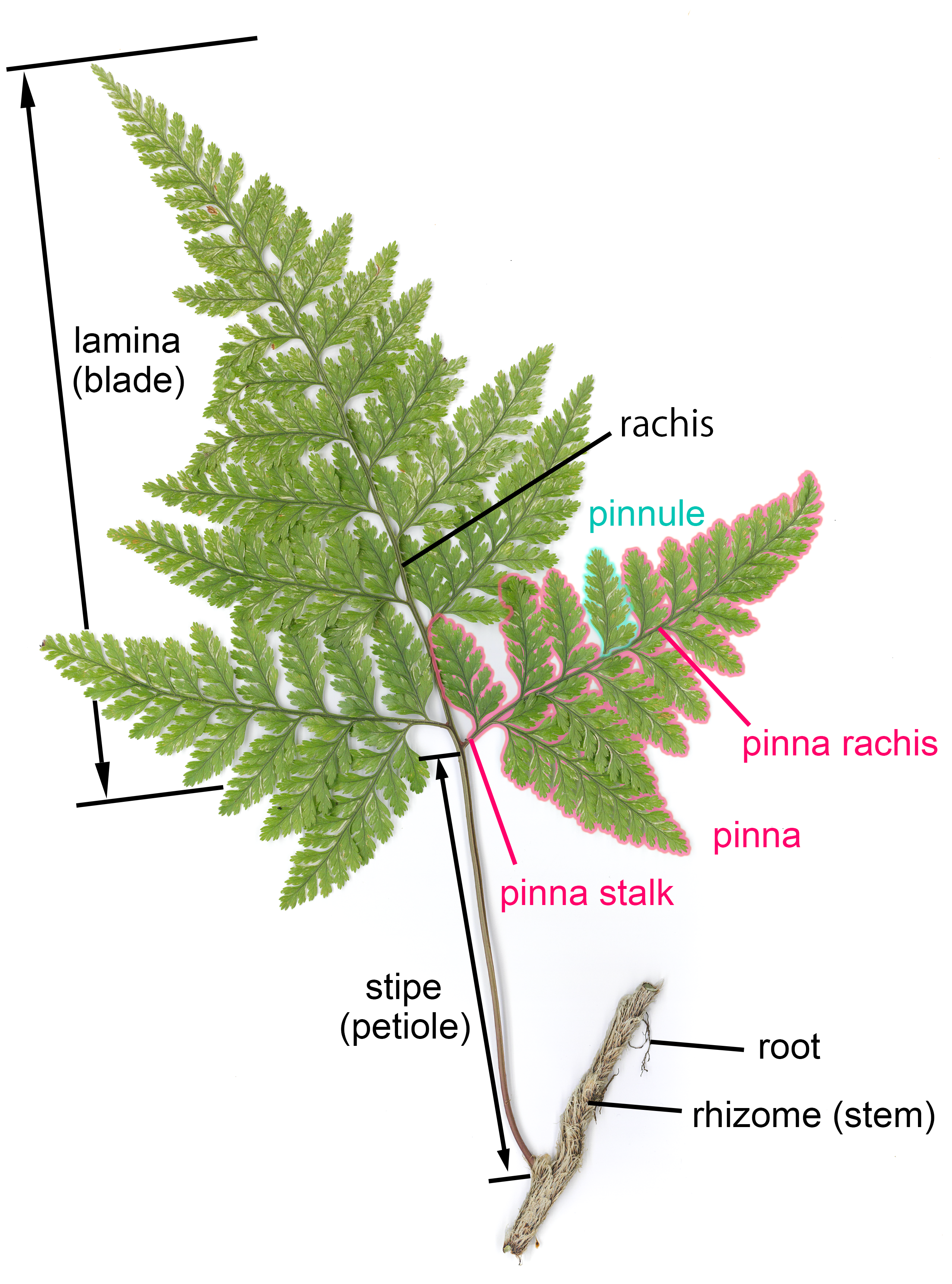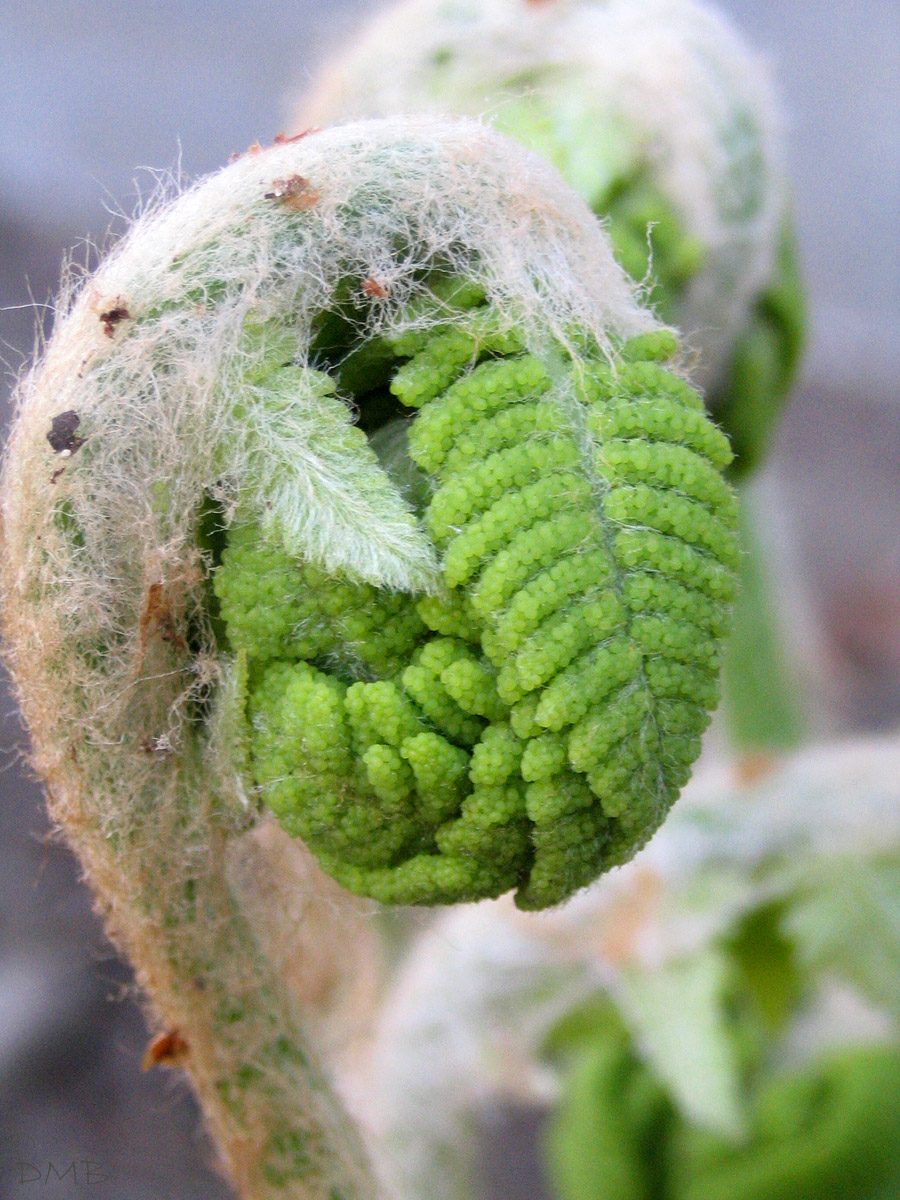|
Frond
A frond is a large, divided leaf. In both common usage and botanical nomenclature, the leaves of ferns are referred to as fronds and some botanists restrict the term to this group. Other botanists allow the term frond to also apply to the large leaves of cycads, as well as palms (Arecaceae) and various other flowering plants, such as mimosa or sumac. "Frond" is commonly used to identify a large, compound leaf, but if the term is used botanically to refer to the leaves of ferns and algae it may be applied to smaller and undivided leaves. Fronds have particular terms describing their components. Like all leaves, fronds usually have a stalk connecting them to the main stem. In botany, this leaf stalk is generally called a Petiole (botany), petiole, but in regard to fronds specifically it is called a Stipe (botany), stipe, and it supports a flattened blade (which may be called a lamina), and the continuation of the stipe into this portion is called the rachis. The blades may be ... [...More Info...] [...Related Items...] OR: [Wikipedia] [Google] [Baidu] |
Frondose
Frondosity (from Latin ''frondōsus'' meaning 'leafy') is the property of an organism that normally flourishes with fronds or leaf-like structures. Many frondose organisms are thalloid and lack the organization of tissues into organs, with the exception of ferns. Frondosity is significant mainly for distinguishing particular types of Seaweed, macroscopic algae, and in paleobotany and paleontology, by analyzing features present in fossil biota. Frondose macroalgae are relevant to the ecology of many marine and coastal ecosystems. Large frondose algae play an important role in the creation and functioning of healthy ecosystems from kelp forests to similar habitats. Yet, in coral reefs, frondose seaweed can be recognized as harmful due to the link between Algal bloom, excessive blooms and coastal eutrophication. Ediacaran biota The Taphonomy, fossil record from the Ediacaran, Ediacaran Period is sparse, as more easily fossilized hard-shelled animals had yet to evolve. Most fos ... [...More Info...] [...Related Items...] OR: [Wikipedia] [Google] [Baidu] |
Fern
The ferns (Polypodiopsida or Polypodiophyta) are a group of vascular plants (plants with xylem and phloem) that reproduce via spores and have neither seeds nor flowers. They differ from mosses by being vascular, i.e., having specialized tissues that conduct water and nutrients, and in having life cycles in which the branched sporophyte is the dominant phase. Ferns have complex leaf, leaves called megaphylls that are more complex than the microphylls of clubmosses. Most ferns are leptosporangiate ferns. They produce coiled Fiddlehead fern, fiddleheads that uncoil and expand into fronds. The group includes about 10,560 known extant species. Ferns are defined here in the broad sense, being all of the Polypodiopsida, comprising both the leptosporangiate (Polypodiidae (plant), Polypodiidae) and eusporangiate ferns, the latter group including horsetails, Psilotaceae, whisk ferns, marattioid ferns, and ophioglossoid ferns. The fern crown group, consisting of the leptosporangiates and ... [...More Info...] [...Related Items...] OR: [Wikipedia] [Google] [Baidu] |
Glossary Of Botanical Terms
This glossary of botanical terms is a list of definitions of terms and concepts relevant to botany and plants in general. Terms of plant morphology are included here as well as at the more specific Glossary of plant morphology and Glossary of leaf morphology. For other related terms, see Glossary of phytopathology, Glossary of lichen terms, and List of Latin and Greek words commonly used in systematic names. A B ... [...More Info...] [...Related Items...] OR: [Wikipedia] [Google] [Baidu] |
Vernation
Vernation or leafing is the formation of new leaves or fronds. In plant anatomy, it is the arrangement of leaves in a bud. In pine species, new leaves are short and encased in sheaths. Each leaf bundle consists of two to five needles. All the leaves on one section of branch grow in length together. In cabbage species, new leaves are folded over, each covered by the previous leaf. Name The term ''vernation'' is borrowed from New Latin , the act of being verdant or flourishing (). It is cognate with (Latin for " spring") and ("vernal"). Circinate vernation Circinate vernation is the manner in which most fern fronds emerge. As the fern frond is formed, it is tightly curled so that the tender growing tip of the frond (and each subdivision of the frond) is protected within a coil. At this stage it is called a crozier (after the shepherd's crook) or fiddlehead (after the scrollwork at the top of a violin). As the lower parts of the frond expand and toughen up, they begin ... [...More Info...] [...Related Items...] OR: [Wikipedia] [Google] [Baidu] |
Frond Dimorphism
Frond dimorphism refers to a difference in ferns between the fertile and sterile fronds. Since ferns, unlike flowering plants, bear spores on the leaf blade itself, this may affect the form of the frond itself. In some species of ferns, there is virtually no difference between the fertile and sterile fronds, such as in the genus ''Dryopteris'', other than the mere presence of the sori, or fruit-dots, on the back of the fronds. Some other species, such as '' Polystichum acrostichoides'' (Christmas fern), or some ferns of the genus '' Osmunda'', feature dimorphism on a portion of the frond only. Others, such as some species of '' Blechnum'' and '' Woodwardia'', have fertile fronds that are markedly taller than the sterile. Still others, such as '' Osmunda cinnamomea'' (Cinnamon fern), or plants of the family Onocleaceae, have fertile fronds that are completely different from the sterile. Only members of the '' Onocleaceae'' and '' Blechnaceae'' exhibit a propensity towards dimorphy ... [...More Info...] [...Related Items...] OR: [Wikipedia] [Google] [Baidu] |
Sorus
A sorus (: sori) is a cluster of sporangia (structures producing and containing spores) in ferns and fungi. A coenosorus (: coenosori) is a compound sorus composed of multiple, fused sori. Etymology This Neo-Latin word is from Ancient Greek σωρός (''sōrós'' 'stack, pile, heap'). Structure In lichens and other fungi, the sorus is surrounded by an external layer. In some red algae, it may take the form of depression into the thallus. In ferns, the sori form a yellowish or brownish mass on the edge or underside of a fertile frond. In some species, they are protected during development by a scale or film of tissue called the indusium (: indusia), which forms an umbrella-like cover. Life cycle significance Sori occur on the sporophyte generation, the sporangia within producing haploid meiospores. As the sporangia mature, the indusium shrivels so that spore release is unimpeded. The sporangia then burst and release the spores. As an aid to identification The shape, arrang ... [...More Info...] [...Related Items...] OR: [Wikipedia] [Google] [Baidu] |
Pinnate
Pinnation (also called pennation) is the arrangement of feather-like or multi-divided features arising from both sides of a common axis. Pinnation occurs in biological morphology, in crystals, such as some forms of ice or metal crystals, and in patterns of erosion or stream beds. The term derives from the Latin word ''pinna'' meaning "feather", "wing", or " fin". A similar concept is "pectination", which is a comb-like arrangement of parts (arising from one side of an axis only). Pinnation is commonly referred to in contrast to "palmation", in which the parts or structures radiate out from a common point. The terms "pinnation" and "pennation" are cognate, and although they are sometimes used distinctly, there is no consistent difference in the meaning or usage of the two words.Jackson, Benjamin, Daydon; ''A Glossary of Botanic Terms with their Derivation and Accent''. Gerald Duckworth & Co. London, 4th ed 1928. Plants Botanically, pinnation is an arrangement of discrete ... [...More Info...] [...Related Items...] OR: [Wikipedia] [Google] [Baidu] |
Blechnum
''Blechnum'', known as hard fern, is a genus of ferns in the family Blechnaceae, subfamily Blechnoideae, according to the Pteridophyte Phylogeny Group classification of 2016 (PPG I). Two very different circumscriptions of the genus are used by different authors. In the PPG I system, based on Gasper et al. (2016), ''Blechnum'' is one of 18 genera in the subfamily Blechnoideae, and has about 30 species. Other sources use a very broadly defined ''Blechnum'' s.l., including accepting only two other genera in the subfamily. The genus then has about 250 species. In the PPG I circumscription, the genus is mostly neotropical, with a few southern African species. Description Plants in the genus ''Blechnum'' (as circumscribed in the PPG I classification) are mainly terrestrial or grow on rocks; few are epiphytes. Their rhizomes may be upright or creeping and have scales with entire margins or at most a few very small teeth. They generally form stolon In biology, a stolon ( from La ... [...More Info...] [...Related Items...] OR: [Wikipedia] [Google] [Baidu] |
Leaf
A leaf (: leaves) is a principal appendage of the plant stem, stem of a vascular plant, usually borne laterally above ground and specialized for photosynthesis. Leaves are collectively called foliage, as in "autumn foliage", while the leaves, stem, flower, and fruit collectively form the Shoot (botany), shoot system. In most leaves, the primary Photosynthesis, photosynthetic Tissue (biology), tissue is the palisade mesophyll and is located on the upper side of the blade or lamina of the leaf, but in some species, including the mature foliage of ''Eucalyptus'', palisade mesophyll is present on both sides and the leaves are said to be isobilateral. The leaf is an integral part of the stem system, and most leaves are flattened and have distinct upper (Glossary of botanical terms#adaxial, adaxial) and lower (Glossary of botanical terms#abaxial, abaxial) surfaces that differ in color, Trichome, hairiness, the number of stomata (pores that intake and output gases), the amount and ... [...More Info...] [...Related Items...] OR: [Wikipedia] [Google] [Baidu] |




